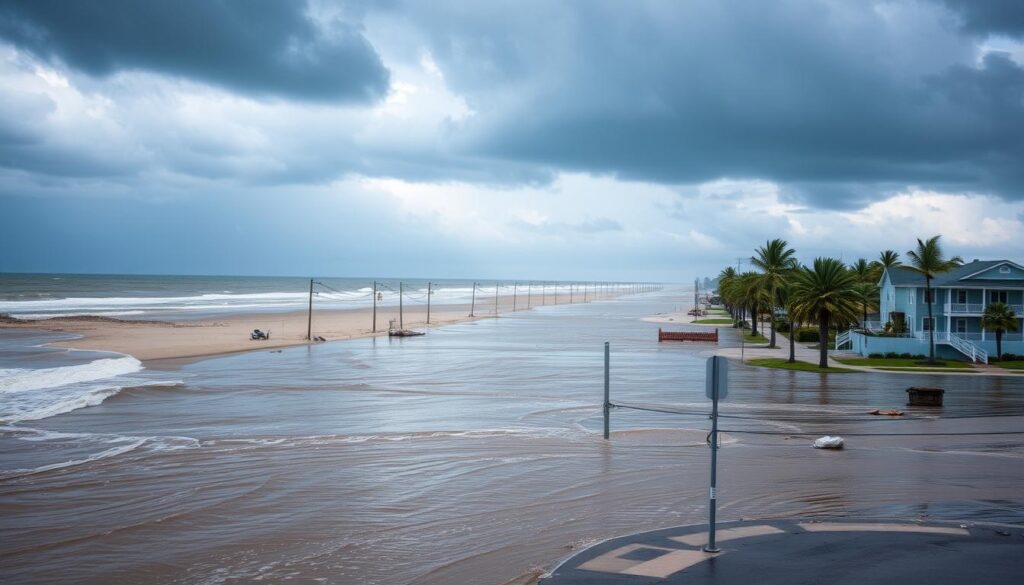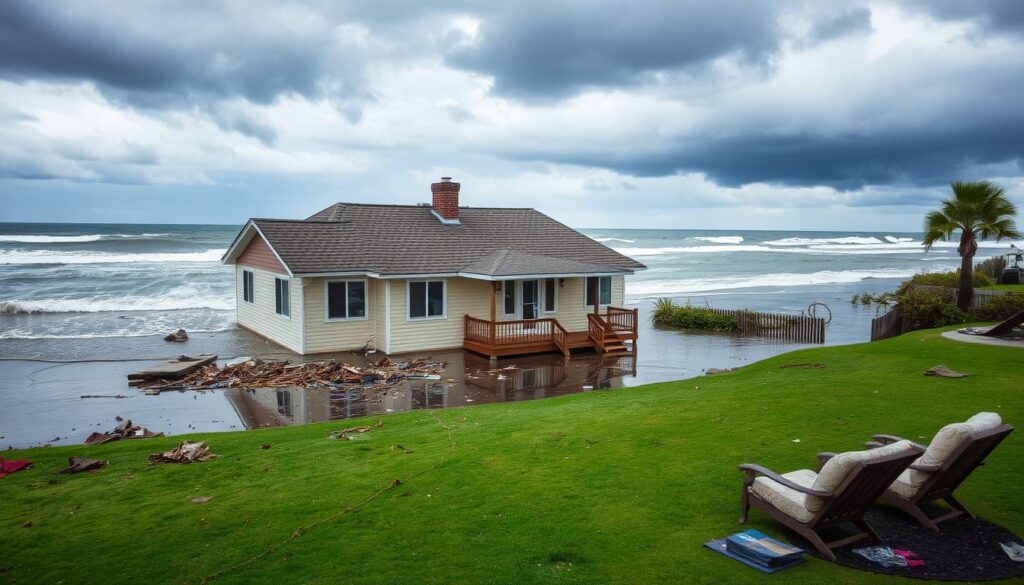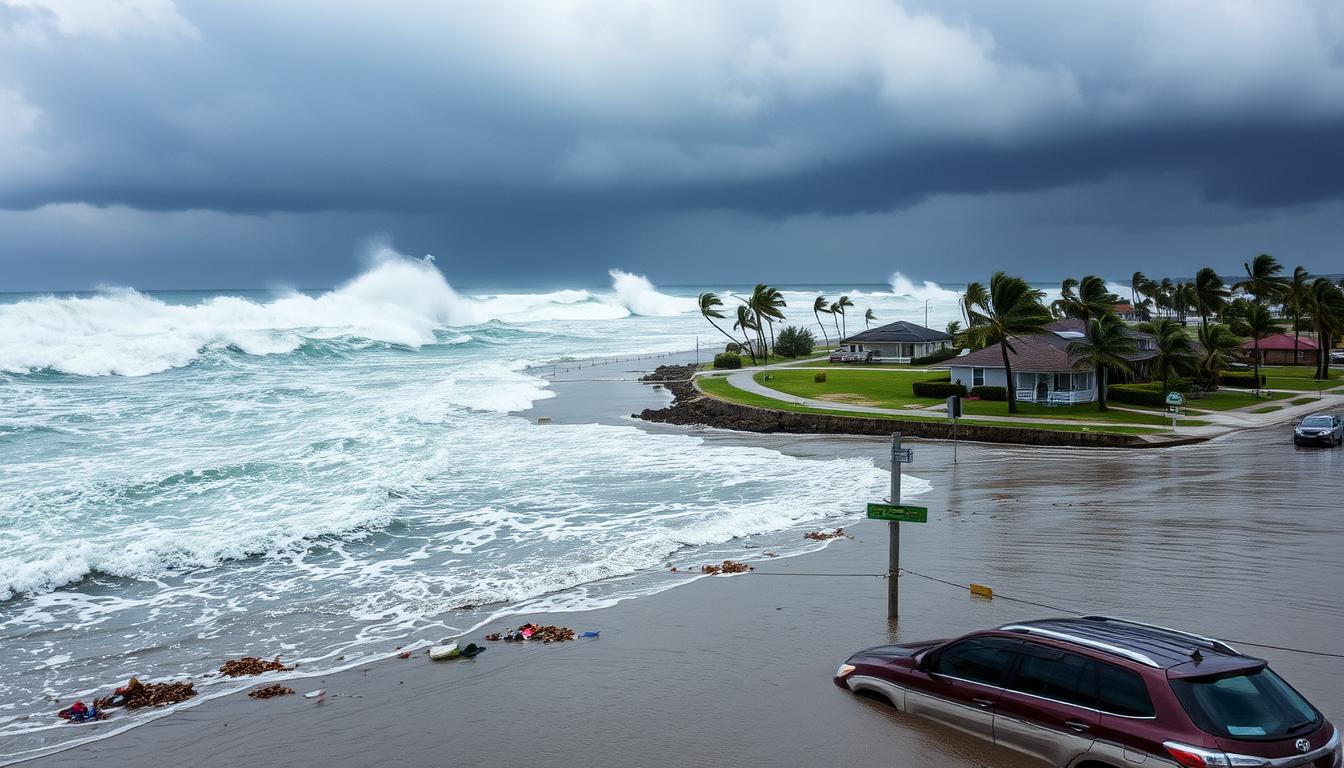As the sun set, a warm glow enveloped the coastal town, but unease grew. The tides, once predictable, now threatened to engulf the shore. A coastal flood warning had been issued, signaling the danger of high water levels and potential property damage.
During such times, staying informed and prepared is vital. This article will guide you through the necessary steps to ensure your safety and protect your home. We’ll cover everything from recognizing warning signs to creating an emergency plan. You’ll gain the knowledge and tools to navigate the storm and come out stronger.
Key Takeaways
- Coastal flooding can occur due to heavy rain, storm surges, and high tides, leading to dangerous conditions that can threaten lives and property.
- It’s crucial to stay informed and prepared when a coastal flood warning is issued to protect yourself and your home.
- This article will provide essential safety tips and precautions to help you navigate a coastal flooding event.
- Understanding the different types of coastal flood warnings and their implications is the first step to staying safe.
- Developing an emergency plan and knowing how to prepare your property can make all the difference in weathering the storm.
Understanding Coastal Flood Warnings
Coastal flooding poses a significant threat, making it essential to grasp the nuances of warnings issued by authorities. Recognizing the distinction between a coastal flood watch and a coastal flood warning is vital. It empowers you to take necessary precautions to safeguard yourself and your property.
What is a Coastal Flood Watch?
A coastal flood watch is issued when there’s a chance of sea water overflowing dunes and sea walls. This indicates potential flooding if weather conditions unfold as forecasted. If a coastal flood watch is issued for your area, prepare to relocate to safe zones if flooding happens or a coastal flood warning is issued.
What is a Coastal Flood Warning?
A coastal flood warning signifies that sea water is already spilling over dunes and sea walls, or is about to within the next 12 hours. This is a critical situation, requiring immediate action to safeguard lives and property. Actions may include evacuating low-lying areas, securing your home, and avoiding floodwaters.
Being informed about coastal flood alerts and preparedness can greatly enhance your safety during flooding events. Register for emergency alerts in your area and understand your local flood risk. This ensures you’re ready to act swiftly if a warning is issued.
Coastal Flood Warning
Coastal communities face a grave threat when flooding looms. A coastal flood warning alerts residents to the danger ahead. It signals that flooding is imminent or already underway, caused by heavy rain, storm surges, or high tides. These warnings are crucial for safeguarding lives and property in vulnerable areas, offering precious time to act.
A coastal flood warning demands serious attention. It indicates a high risk of coastal inundation, which can cause significant damage, disrupt transportation, and even lead to loss of life. It is imperative for coastal communities to take these warnings seriously and prepare accordingly to ensure their safety.
On the other hand, a flood advisory is issued when flooding is expected to be less severe but still poses a risk. Though less urgent than a coastal flood warning, it still necessitates vigilance and preparedness for potential flooding.
Moreover, a hurricane warning often leads to a coastal flood warning due to the potential for severe storm surges and coastal inundation. Residents in hurricane-prone areas must be particularly alert to these warnings. They must take immediate action to safeguard themselves and their property.
| Warning Type | Description | Recommended Action |
|---|---|---|
| Coastal Flood Warning | Flooding is imminent or occurring along the coast due to factors like heavy rain, storm surges, or high tides. | Take immediate action to protect yourself and your property. |
| Flood Advisory | Flooding is expected to be less severe but still poses a threat to the area. | Remain vigilant and prepared for potential flooding. |
| Hurricane Warning | A hurricane is expected to make landfall, potentially bringing with it storm surges and coastal inundation. | Take necessary precautions and follow evacuation orders if issued. |
Coastal flood warnings are vital for the safety of communities near the shoreline. Understanding the importance of these warnings and preparing accordingly can help mitigate the effects of coastal flooding. This proactive approach protects homes and loved ones from potential harm.
Preparing for Coastal Flooding
Coastal flooding poses a significant threat to communities. However, being prepared can ensure your safety and that of your family. Follow these essential steps to prepare for potential flooding events.
Know Your Flood Risk
Understanding your property’s flood risk is the first step in preparing for coastal flooding. Use flood maps to determine if your home or business is in a high-risk area. This knowledge aids in making informed decisions about emergency planning and protective measures.
Sign Up for Emergency Alerts
Register for local emergency notification systems to receive timely warnings about coastal flood watches and warnings. These alerts are crucial for knowing about evacuations, road closures, and other safety instructions during a flooding event.
Create an Emergency Plan
Develop a detailed emergency plan that outlines evacuation procedures, safe meeting places, and steps to protect your property. Ensure you have essential supplies, such as flashlights, batteries, and a first-aid kit, ready for quick departure from your home.

“Being prepared can make all the difference when it comes to weathering a coastal flood. Taking the time to understand your risk and create a plan can help keep you and your loved ones safe.”
By taking proactive measures, you can enhance your chances of surviving a coastal flooding event. This approach minimizes the impact on your family and community.
Staying Safe During Coastal Flooding
When a coastal flood warning is issued, immediate action is crucial for your safety. The evacuation procedures and precautions you take can be the difference between safety and danger. It’s vital to understand the importance of these steps.
Evacuation Procedures
If authorities order an evacuation, it’s essential to follow their instructions promptly. Leave the area as soon as possible and stick to designated evacuation routes. Avoid shortcuts, as they might be blocked or submerged. Prepare an emergency kit with essential items. Do not attempt to return home until officials confirm it is safe.
Avoiding Floodwaters
The floodwaters pose a significant danger during coastal flooding. Never try to drive or walk through flooded areas. The depth and currents can be deceptive and treacherous. Remember the crucial flood safety mantra: “Turn around, don’t drown.” If you encounter a flooded road, find an alternate route immediately.
| Evacuation Tips | Floodwater Risks |
|---|---|
|
|
By understanding and following the proper evacuation procedures and flood safety guidelines, you can significantly improve your chances of weathering a coastal flood event safely.
Flood Safety Rules for Coastal Areas
When a coastal flood safety event occurs, it’s vital to adhere to basic precautions. Coastal flooding can be unpredictable and poses significant dangers. Therefore, staying informed and prepared is essential for flood preparedness.
Here are key flood safety rules to remember when in or visiting coastal areas:
- Avoid flood-prone zones. Steer clear of low-lying areas, beaches, and other locations susceptible to coastal flooding.
- Move to higher ground. If a flood threatens your area, quickly relocate to a safer, elevated location.
- Refrain from driving or walking through floodwaters. Even shallow water can be treacherous and hide hidden dangers.
- Be extra cautious at night. It’s harder to recognize the risks of coastal flooding in the dark, so exercise heightened vigilance.
- If stranded, stay indoors and ascend to the highest floor. Bring essential supplies like water, food, a flashlight, and a portable radio.
By adhering to these simple flood safety guidelines, you can greatly enhance your chances of safely navigating a coastal flooding event. Remember, being prepared and staying informed is crucial for flood preparedness in coastal areas.
“The safety of our communities is our top priority, and adhering to these flood safety rules is crucial for protecting lives during coastal flooding events.”

Risks of Coastal Flooding
Coastal flooding poses serious risks, affecting both property and human health. Rising floodwaters can cause extensive property damage to homes, businesses, and critical infrastructure. This leads to costly repairs and long-term displacement. Moreover, coastal flood risks expose people to various health hazards.
Property Damage
Coastal flooding can severely damage buildings and infrastructure. Floodwaters can harm foundations, walls, and electrical systems, making homes and businesses uninhabitable. In severe cases, property damage from coastal flooding can take months or even years to recover from.
Health Hazards
Coastal flooding also poses serious health hazards. Floodwaters can be contaminated with sewage, chemicals, and other dangerous materials. This increases the risk of waterborne illnesses and infections. Moreover, there’s a risk of electrocution and exposure to sharp debris.
| Potential Property Damage | Potential Health Hazards |
|---|---|
|
|
Coastal residents must take all necessary precautions to protect themselves and their property from risks of coastal flooding. Understanding the potential dangers and taking proactive measures can help minimize the impact of these devastating events.

“Coastal flooding can have a devastating impact on both personal property and public infrastructure. It’s essential that communities take steps to prepare and mitigate these risks.”
Surviving After a Coastal Flood
After a coastal flood hits, the situation can seem overwhelming. Yet, by taking the right steps and following safety rules, you can safely get through the recovery and return home. It’s crucial to wait for official clearance before heading back.
Returning Home Safely
When given the all-clear to return, be on the lookout for dangers. Check your home for electrical problems, contaminated water, or structural damage. Wear protective gear like waterproof boots and gloves to stay safe while inspecting.
Cleaning Up After Flooding
Cleaning up after a flood recovery is a tough task but vital. Dispose of any damaged or tainted items responsibly. Make sure to dry your home completely. If needed, hire flood cleanup experts for a thorough and safe restoration.
Dealing with a coastal flood’s aftermath demands patience, effort, and a focus on flood safety. By adhering to the right steps and prioritizing your safety, you can return home and start the flood recovery journey.
“The true test of a person’s character is how they handle the tough situations in life.”
Storm Surge and Tidal Flooding
Coastal regions face significant threats from storm surge and tidal flooding. These events can greatly increase the severity of coastal flooding, endangering communities.
Storm surge occurs when storms bring strong winds and low pressure, causing water levels to rise abnormally. This surge can elevate water far beyond the usual high tide, flooding coastal areas extensively. On the other hand, tidal flooding happens when high tides exceed normal levels, also flooding coastal regions.
The combination of storm surge and tidal flooding can intensify the effects of coastal flooding. It’s vital for communities to grasp the dynamics of these factors. This knowledge is key to preparing and responding effectively, protecting lives and property.
| Characteristic | Storm Surge | Tidal Flooding |
|---|---|---|
| Cause | Strong winds and low pressure during storms | Abnormally high tides exceeding normal levels |
| Impact | Sudden, dramatic rise in water levels, leading to extensive coastal inundation | Gradual, prolonged flooding of coastal areas during high tide cycles |
| Timing | Typically coincides with the arrival of a storm | Follows the regular tidal patterns, often exacerbated by other factors |
By grasping the distinct traits of storm surge and tidal flooding, coastal communities can enhance their preparedness for coastal flooding. Effective disaster planning is crucial for safeguarding lives and preserving critical infrastructure in these exposed areas.
Shoreline Erosion and Beach Hazards
Coastal flooding’s rise brings significant threats to shoreline erosion and beach hazards. Powerful waves and currents can devastate coastal environments, eroding sand and damaging structures.
Shoreline erosion increases coastal properties’ and infrastructure’s vulnerability. As the shoreline retreats, homes, businesses, and critical structures face the sea’s relentless forces. This can cause damage, flooding, and destruction, endangering lives and livelihoods.
Coastal flooding also brings hazardous debris to beaches, including trees, glass, fishing nets, and sharp metal. These dangers pose a significant risk to beachgoers, who may not be aware of the hidden threats. Ensuring beach safety is crucial in areas hit by coastal flooding and shoreline erosion.
Understanding Coastal Erosion
Coastal erosion is a natural process, but human activities and climate change can worsen it. Understanding shoreline erosion dynamics is vital for effective mitigation strategies and coastal community protection.
“Coastal flooding and erosion are two sides of the same coin, each contributing to the other’s escalation. Addressing these issues holistically is key to building resilient coastal communities.”
The combination of coastal flooding, shoreline erosion, and beach hazards presents a complex challenge. A multifaceted approach is needed to understand and address these risks. Coastal communities can prepare and respond to these environmental concerns by understanding the risks and taking proactive steps.
Coastal Flood Warning: Stay Informed and Prepared
When a coastal flood warning is issued, it’s crucial to stay informed and take immediate action. Protect yourself and your property by monitoring local news and emergency alerts. Heed instructions from authorities and be prepared to evacuate if necessary. This approach significantly increases your chances of safely weathering a coastal flooding event.
Staying informed is the first step in flood preparedness. Sign up for emergency alerts from your local government or weather service. Receive timely notifications about impending coastal floods. These alerts will provide vital information about the severity of the threat, evacuation orders, and any shelter locations that may be opened.
If a coastal flood warning is issued, follow all instructions from emergency officials. This may include evacuating your home or business and seeking higher ground. Be prepared to leave quickly, with a packed emergency kit and important documents. Avoid attempting to drive or walk through flooded areas, as even shallow waters can be dangerous.
By staying vigilant and following safety guidelines, you can protect yourself and your loved ones during a coastal flooding event. Remember, coastal flood warnings are issued for a reason. It’s essential to take them seriously and act quickly to minimize the risks.
“Preparation through education is less costly than learning through tragedy.” – Max Lucado
Conclusion
Coastal flooding is a major threat to communities across the United States. It can cause widespread damage and put lives at risk. Understanding coastal flood warnings and preparing for them can help residents stay safe.
It’s vital to stay informed and follow local authorities’ instructions during a coastal flood watch or warning. Knowing your flood risk, signing up for emergency alerts, and creating an emergency plan are key steps. These actions can help protect you and your loved ones.
During a coastal flood, following evacuation procedures and avoiding floodwaters is crucial. Floodwaters are dangerous and can pose serious health risks. By following flood safety rules and staying vigilant, you can increase your chances of survival. This also helps minimize damage to your property and well-being.
FAQ
What is a Coastal Flood Watch?
A Coastal Flood Watch signals a possibility of sea water overflow over dunes and sea walls, contingent on weather conditions. Residents in the affected area should prepare to relocate to safe zones if flooding occurs or warnings are issued.
What is a Coastal Flood Warning?
A Coastal Flood Warning indicates that sea water overflow is imminent or already happening within the next 12 hours. Those in the warned area must take immediate action to safeguard lives and property.
What should I do to prepare for a coastal flood?
To prepare for a coastal flood, understanding your flood risk is crucial. Sign up for emergency alerts and create a detailed emergency plan. Review flood maps, register for local emergency systems, and develop an evacuation plan. Identify safe meeting spots and gather essential supplies.
What should I do if a coastal flood warning is issued?
If a coastal flood warning is issued, prepare to evacuate immediately. Follow all instructions from local authorities and leave the area as soon as possible. Never attempt to drive or walk through floodwaters, as they can be deeper and more dangerous than they appear.
What are the key flood safety rules during a coastal flood event?
During a coastal flood event, staying away from flood-prone areas is essential. Move to higher ground if flooding threatens. Avoid driving or walking through floodwaters. Be cautious at night, as it’s harder to recognize dangers.
What are the main risks of coastal flooding?
Coastal flooding poses significant risks to property and health. Floodwaters can cause extensive damage to homes, businesses, and infrastructure. They also expose people to contaminated water, dangerous debris, and the risk of electrocution.
What should I do after a coastal flood?
After a coastal flood, wait for authorities to confirm it’s safe to return home. When returning, be cautious of hazards like electrical issues, contaminated water, and structural damage. Wear protective gear during cleanup and be prepared to dispose of damaged or contaminated items properly.
What are the main factors that contribute to coastal flooding?
Coastal flooding is often exacerbated by storm surges and high tides. Storm surges are abnormal rises in water levels generated by strong winds and low atmospheric pressure during storms. Tidal flooding occurs when high tides exceed normal levels.
How can coastal flooding affect the shoreline and beaches?
Coastal flooding can lead to significant shoreline erosion and hazardous beach conditions. Strong waves and currents can wash away sand and undermine coastal structures. This leaves beaches and properties vulnerable to further damage. Coastal flooding can also deposit dangerous debris on beaches, posing a risk to those near the water’s edge.
